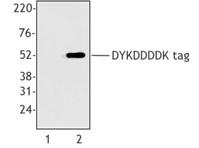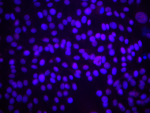- Clone
- Poly6490 (See other available formats)
- Regulatory Status
- RUO
- Other Names
- Protein kinase B alpha (PRK-BA, PKB), Serine/Threonine specific kinase RAC alpha, Protein kinase Akt
- Isotype
- Rabbit Polyclonal IgG
- Ave. Rating
- Submit a Review
- Product Citations
- publications
_Antibody_1_WB_062116.jpg&Width=240&Height=300&altFmImage_path=&Compression=90&Crop=5)
-
_Antibody_1_WB_062116.jpg&Height=80&altFmImage_path=&Compression=90&Crop=5)
Western blot analysis of NIH3T3 starved overnight (lane 1) cell, NIH3T3 starved overnight and treated with PDGF 100ng/ml for 15 minutes (lane 2) and Jurkat (lane 3) cells using anti-AKT Phospho (Ser473) antibody (Poly6490). Purified anti-β-actin Antibody (Poly6221) was used as loading control. -

MDA-MB-231 breast cancer cells were stained with anti-Akt Phospho (Ser473) (clone Poly6490) using 1:50 dilution, followed by Alexa Fluor® 647 anti-rabbit Ig secondary antibody (red) plus DAPI staining for nuclei (blue). Cells were fixed with 4% PFA, permeabilized with 0.1% Triton X-100, blocked with 10% serum, and incubated O/N at 4°C. Images were taken using a TE300 fluorescence microscope under 20x (filter set: EX 647/10x, Dichroic 665LP, EM 700/70x) at exposure 4s. Data provided by John Nolan and Er Liu, La Jolla Bioengineering Institute.
Akt (also known as protein kinase B alpha) is a 60 kD serine/threonine specific kinase containing a pleckstrin domain. Akt plays a critical role in controlling survival and apoptosis. This kinase is ubiquitously expressed and translocates to the membrane upon activation. This protein kinase is activated by insulin and various growth and survival factors to function in a wortmannin-sensitive pathway involving PI 3-kinase. Akt is activated by phospholipid binding and activation loop phosphorylation at Thr308 by PDK1 (4) and by phosphorylation within the carboxy terminus at Ser473. The previously elusive PDK2, responsible for phosphorylation of Akt at Ser473, has been identified as a mammalian target of rapamycin (mTOR) in a rapamycin-insensitive complex with rictor and Sin1. Activated Akt can then phosphorylate a wide range of substrates including transcription factors (e.g. FOXO1), kinases (GSK-3,Raf-1, ASK, Chk1) and other proteins with important signaling roles (e.g. Bad, MDM2). Akt promotes cell survival by inhibiting apoptosis through phosphorylation and by inactivation of several targets, including Bad, forkhead transcription factor, c-Raf and caspase-9. Akt also plays a critical role in cell growth by directly phosphorylating mTOR in a rapamycin-sensitive complex containing raptor. More importantly, Akt phosphorylates and inactivates tuberin (TSC2), an inhibitor of mTOR within the mTOR-raptor complex. The phosphor-Akt (S473) antibody specifically detects phosphorlated Akt at the Ser473 site.
Product DetailsProduct Details
- Verified Reactivity
- Human, Mouse
- Antibody Type
- Polyclonal
- Host Species
- Rabbit
- Immunogen
- Modified Synthetic peptide
- Formulation
- This antibody is provided in phosphate-buffered solution, pH 7.2, containing 0.09% sodium azide and 50% glycerol.
- Preparation
- This antibody was purified by affinity chromatography.
- Concentration
- Lot-specific (to obtain lot-specific concentration and expiration, please enter the lot number in our Certificate of Analysis online tool.)
- Storage & Handling
- Upon receipt, store frozen at -20°C.
- Application
-
WB - Quality tested
ICC - Verified - Recommended Usage
-
Each lot of this antibody is quality control tested by Western blotting. Western blotting suggested working dilution(s): Use 10 µL antibody per 5 mL antibody dilution buffer for each mini-gel. It is recommended that the reagent be titrated for optimal performance for each application.
- Application Notes
-
The optimal concentration should be determined by titration for each individual assay of interest.
This product may contain other non-IgG subtypes. - Application References
- Product Citations
-
- RRID
-
AB_10612760 (BioLegend Cat. No. 649001)
AB_10613474 (BioLegend Cat. No. 649002)
Antigen Details
- Structure
- Serine/Threonine family of kinases, pleckstrin domain; 60 kD
- Distribution
-
Ubiquitously expressed, translocates to the membrane upon activation.
- Function
- Catalytically inactive multimeric complex. Akt is activated by phospholipid binding and activation loop phosphorylation at Thr308 by PDK1 and by phosphorylation within the carboxy terminus at Ser473 by PDK2.
- Interaction
- Interacts through pleckstrin homology domain with second messengers. Interacts with AKTIP, CDKN1B.
- Cell Sources
- Phosphorylates substrates in cytoplasm, nucleus.
- Biology Area
- Apoptosis/Tumor Suppressors/Cell Death, Cell Biology, Neuroscience, Signal Transduction
- Molecular Family
- Phospho-Proteins
- Antigen References
-
1. Jacinto E, et al. 2006. Cell 127:125.
2. Inoki K, et al. 2002. Nat. Cell. Biol. 4:648.
3. Franke TF, et al. 1995. Cell 81:727.
4. Brunet A, et al. 1999. Cell 96:857.
5. Yang WL, et al. 2010 Cell Cycle 9:487. - Gene ID
- 207 View all products for this Gene ID
- UniProt
- View information about Akt Phospho Ser473 on UniProt.org
Related Pages & Pathways
Pages
Related FAQs
Other Formats
View All Akt Phospho (Ser473) Reagents Request Custom Conjugation| Description | Clone | Applications |
|---|---|---|
| Purified anti-Akt Phospho (Ser473) | Poly6490 | WB,ICC |
Customers Also Purchased



Compare Data Across All Formats
This data display is provided for general comparisons between formats.
Your actual data may vary due to variations in samples, target cells, instruments and their settings, staining conditions, and other factors.
If you need assistance with selecting the best format contact our expert technical support team.
-
Purified anti-Akt Phospho (Ser473)
_Antibody_1_WB_062116.jpg&Width=150&altFmImage_path=&Crop=5)
Western blot analysis of NIH3T3 starved overnight (lane 1) c... 
MDA-MB-231 breast cancer cells were stained with anti-Akt Ph...
 Login / Register
Login / Register 








Follow Us